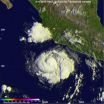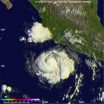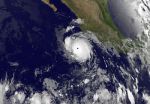(Press-News.org) VIDEO:
On June 11, NASA's TRMM satellite found rain falling at a rate of over 74.4 mm/2.9 inches per hour in a strong feeder band east of Hurricane Cristina's eye.Another area...
Click here for more information.
A fleet of satellites from NASA and NOAA are on the job monitoring the first major hurricane of the Eastern Pacific Ocean Season as Hurricane Cristina has reached Category 4 status on the Saffir-Simpson scale.
This morning, June 12, at 1200 UTC (8 a.m. EDT), NOAA's GOES-West satellite provided an infrared image of Hurricane Cristina that showed a very clear, distinct eye. Although Cristina's center is over open ocean, this intense hurricane is causing rough surf along the west coast of Mexico today. The National Hurricane Center (NHC) noted that swells continue to affect southwestern Mexico, and could cause life-threatening surf and riptide conditions.
NHC noted in the discussion at 11 a.m. EDT (8 a.m. PDT) that Cristina has gone through an extraordinary, but not unprecedented, phase of rapid intensification during the past 24 hours, with its maximum winds increasing by about 65 knots (74.8 mph/120.4 kph) since that time on June 11.
When the TRMM satellite flew over Cristina on June 11, 2014 at 1142 UTC (4:42 a.m. PDT) it was a hurricane. A rainfall analysis that used data from TRMM's Microwave Imager (TMI) and Precipitation Radar (PR) instruments was overlaid on an enhanced infrared image received by NOAA's GOES-East satellite at 1145 UTC (7:45 a.m. EDT) to provide a complete picture of the hurricane's cloud extent and rainfall rates. The TRMM TMI data clearly revealed that an eye had developed indicating that Cristina was definitely a hurricane. TRMM PR found that rain was falling at a rate of over 74.4 mm (2.9 inches) per hour in a strong feeder band east if Cristina's eye. Another smaller area of strong convective thunderstorms west of Puerto Vallarta, Mexico was also found to contain very heavy rainfall with the tallest thunderstorm tops reaching heights of about 16.5km (10.2 miles).
Later on June 11, at 19:59 UTC (3:59 p.m. EDT) when NASA's Aqua satellite passed over Hurricane Christina as it was rapidly intensifying, the Atmospheric Infrared Sounder (AIRS) instrument gathered infrared data on the cloud top temperatures of the storm. By early morning on June 12, Cristina had a circular central dense overcast with very cold cloud tops near -80C (-112F).
At 11 a.m. EDT (8 a.m. PDT) on June 12, Hurricane Cristina's maximum sustained wind were near 150 mph (240 kph). Cristina was about 250 miles (400 km) southwest of Manzanillo, Mexico, near latitude 16.6 north and longitude 107.1 west. Cristina was moving toward the west-northwest near 8 mph (13 kph) and a northwestward to west-northwestward motion is expected through Saturday morning (June 14).The estimated minimum central pressure is 935 millibars.
The NHC said that light vertical wind shear and a deep warm ocean should allow Cristina to maintain major hurricane strength for another 36 hours.
INFORMATION:
Text credit: Rob Gutro
NASA's Goddard Space Flight Center
NASA and NOAA satellites analyze Category 4 Hurricane Cristina
2014-06-12
ELSE PRESS RELEASES FROM THIS DATE:
Families like practical group wellness program -- and lose weight
2014-06-12
Seattle, WA—Many children are obese these days, but what can be done about it? Research-proven treatments for obesity exist, but they rely on regular one-on-one meetings with a trained health coach. So these "behavioral" treatments are seldom available outside of research studies in specialty medical centers.
It's feasible and acceptable to give this same kind of behavioral treatment to groups of families in primary care, Paula Lozano, MD, MPH, found. She published results of the Family Wellness Program in the Permanente Journal. She is a Group Health pediatrician and ...
Standing up gets groups more fired up for team work
2014-06-12
June 12, 2014 – Chairs provide great support during long meetings, but they may also be holding us back. Standing during meetings boosts the excitement around creative group processes and reduces people's tendency to defend their turf, according to a new study that used wearable sensors.
"Organizations should design office spaces that facilitate non-sedentary work," says Andrew Knight of the Olin Business School at Washington University. Removing chairs could be a low-cost way to redesign an office space while also tackling the health effects of sitting in one place ...
Heart rate variability may predict risk of disease in premature infants
2014-06-12
Measuring variability of heart rate may identify premature infants at risk of developing necrotizing enterocolitis, a serious inflammatory condition that can lead to death, according to Penn State College of Medicine researchers.
Necrotizing enterocolitis, or NEC, may lead to destruction of the intestinal wall and vital organ failure. It affects 6 to 10 percent of premature infants within the first two weeks of life.
"NEC is currently diagnosed by a combination of laboratory and radiology tests, usually done when the disease is already significant," said Kim Doheny, director ...
Acidification and warming threaten Mediterranean Sea iconic species
2014-06-12
This is of particular importance to the Mediterranean coastal societies with 300 million inhabitants (living and visiting), unique ecosystems, love of seafood and its role as a focus for tourist worldwide.
Research professor Patrizia Ziveri, from Institute of Environmental Science and Technology at the UAB and the coordinator of the project says "We knew next to nothing about the combined effects of warming and acidification in the Mediterranean until this study, now we know that they are a serious double threat to our marine ecosystems."
"Iconic Mediterranean ecosystems ...
Fungal protein found to cross blood-brain barrier
2014-06-12
(SACRAMENTO, Calif.) — In a remarkable series of experiments on a fungus that causes cryptococcal meningitis, a deadly infection of the membranes that cover the spinal cord and brain, investigators at UC Davis have isolated a protein that appears to be responsible for the fungus' ability to cross from the bloodstream into the brain.
The discovery — published online June 3 in mBio, the open-access, peer-reviewed journal of the American Society for Microbiology — has important implications for developing a more effective treatment for Cryptococcus neoformans, the cause ...
Racism in healthcare linked to poor mental health
2014-06-12
The VicHealth-funded survey, published in the latest edition of the Medical Journal of Australia, could go some way to explaining the reduced quality of healthcare often reported by Indigenous communities.
Led by Associate Professor Margaret Kelaher and researcher Angeline Ferdinand in collaboration with Professor Yin Paradies from Deakin University, the survey examined experiences of racism in health settings alongside other areas including workplaces, education and sport and their impact on mental health among Aboriginal Australians.
Of the 755 survey participants, ...
Active particles may enhance phase separation
2014-06-12
Systems containing self-propelling particles, such as bacteria or artificial colloidal particles, are always out of equilibrium but may show interesting transitions between different states, reminiscent of phase transitions in equilibrium. However, application of analytical and computational methodologies from equilibrium statistical mechanics is questionable to study properties of such active systems. An international team of researchers – including Dr. Peter Virnau and Professor Kurt Binder of Johannes Gutenberg University Mainz (JGU), Benjamin Trefz of the JGU Graduate ...
Immune response affects sleep and memory -- new study
2014-06-12
Fighting off illness- rather than the illness itself- causes sleep deprivation and affects memory, a new study has found.
University of Leicester biologist Dr Eamonn Mallon said a common perception is that if you are sick, you sleep more.
But the study, carried out in flies, found that sickness induced insomnia is quite common.
The research has been published in the journal PeerJ at: http://peerj.com/articles/434
Dr Mallon said: "Think about when you are sick. Your sleep is disturbed and you're generally not feeling at your sharpest. Previously work has been ...
Twelve minutes of exercise improves attention, reading comprehension in low-income adolescents
2014-06-12
HANOVER, N.H. – June 12, 2014 – A new Dartmouth study shows 12 minutes of exercise can improve attention and reading comprehension in low-income adolescents, suggesting that schools serving low-income populations should work brief bouts of exercise into their daily schedules.
The study, published as part of the June volume of Frontiers in Psychology, compared low-income adolescents with their high-income peers. While both groups saw improvement in selective visual attention up to 45 minutes after exercising, the low-income group experienced a bigger jump. (Selective visual ...
Potential new treatment may protect celiac patients from gluten-induced injury
2014-06-12
Bethesda, MD (June 12, 2014) — The gluten-specific enzyme ALV003 reduces a patient's exposure to gluten and its potential harm, according to a new phase 2 study appearing in Gastroenterology1, the official journal of the American Gastroenterological Association. This study is the first to find that a non-dietary intervention can potentially benefit celiac disease patients.
Study participants were put on an everyday gluten-free diet, challenged with up to 2 grams of gluten daily (equivalent to approximately one half of a standard slice of bread in the U.S.). Researchers ...




